By Wayne Cottrell — The Dinosaur Country Cruise is a 48.1-mile, out-and-back ride over gently rolling hills and false flats. The ride journeys from Vernal, into the Dinosaur National Monument as far as the pavement stretches, and then returns. The pavement surface is good along the outer ends of the route (i.e., in Vernal, and approaching and in Dinosaur National Monument) but is fair to rough along Brush Creek Road, in the middle section of the course. There are ten cattle guard crossings. The elevation ranges from 5,359 feet in Vernal to 4,757 feet along State Highway (SR) 149 near Dinosaur National Monument.
The main feature of the ride is Dinosaur National Monument, which was the site, in 1909, of the discovery of a rich cache of dinosaur fossils. Among the fossils found were those of the allosaurus, apatosaurus, barosaurus, brontosaurus, camarasaurus, camptosaurus, ceratosaurus, diplodocus, dryosaurus, stegosaurus, and torvosaurus—an impressive quarry. The discovery forever changed Utah’s role in paleontological history, and led to the creation of the Dinosaur National Monument, along with other dinosaur-related attractions in Utah (such as the Dinosaur Diamond Prehistoric Byway). The monument began as a quarry; today, a visitor center allows the general public to view the ongoing process of fossil evaluation, as well as an authentic dig. Later, the site was expanded to include opportunities for river rafting, hiking, scenic drives, and geological exploration in the Yampa and Green River Canyons. Although the monument headquarters is located in Dinosaur, Colorado, the Utah side features the Quarry Visitor Center and the Green River.
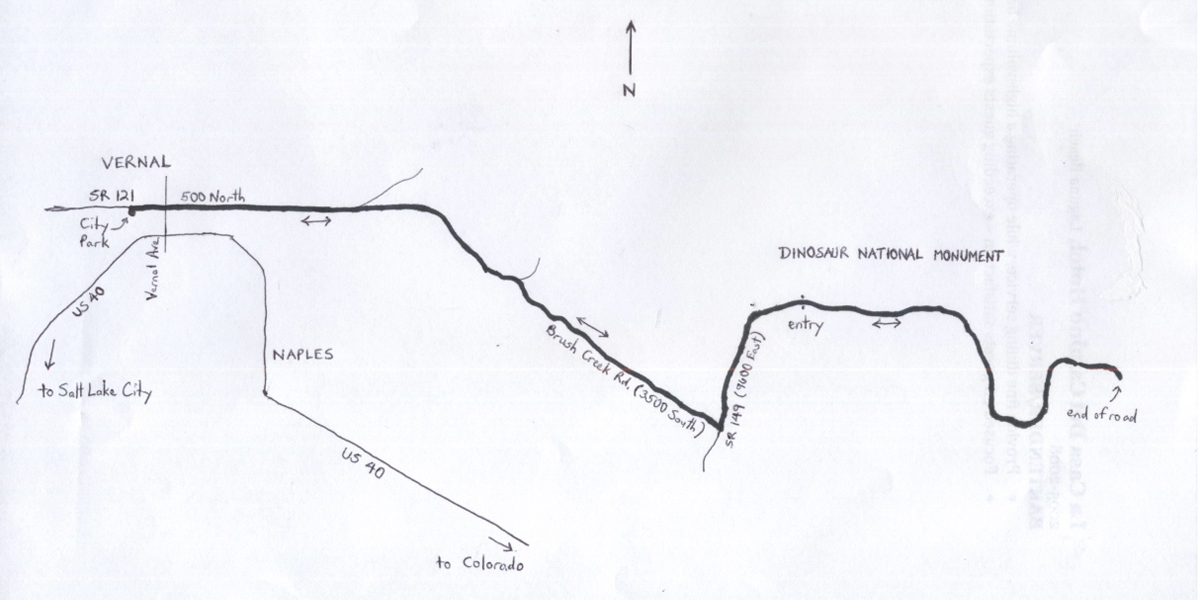 The ride begins in Vernal, Dinosaurland’s largest city and center of commercial activity (population 9,089 in 2010). Several facts distinguish Vernal: One of the few Utah towns founded by non-Mormons, and the largest city in the United States with no railroad are two of the city’s claims to fame. Monuments to Tyrannosaurus rex and a creature that resembles Barney stand at two of the city’s gateways. The city has a hard, rural, industrial feel, perhaps because of the city’s outlaw past, and the work involved in water reclamation and oil-extraction projects. But the city has a “soft” side, with plenty of outfitters providing for the region’s recreational opportunities, museums, and a few outstanding examples of architecture.
The ride begins in Vernal, Dinosaurland’s largest city and center of commercial activity (population 9,089 in 2010). Several facts distinguish Vernal: One of the few Utah towns founded by non-Mormons, and the largest city in the United States with no railroad are two of the city’s claims to fame. Monuments to Tyrannosaurus rex and a creature that resembles Barney stand at two of the city’s gateways. The city has a hard, rural, industrial feel, perhaps because of the city’s outlaw past, and the work involved in water reclamation and oil-extraction projects. But the city has a “soft” side, with plenty of outfitters providing for the region’s recreational opportunities, museums, and a few outstanding examples of architecture.
Start the ride at Vernal City Park; head east on 500 North from 900 West. Where 500 North curves to the right to become 500 West, turn left to continue on 500 North (mile 0.3). Cross Vernal Avenue and continue heading east. The roadsides become increasingly rural through here: open space, pasture, and fewer houses. At the fork in the road (mile 3.9), veer right onto Brush Creek Road. The pavement surface gets rough here; watch out for potholes. The vista is of a desolate, dry landscape. The road turns downhill at mile 7.3; stay right at the Y intersection at mile 7.8. Climb out of this “saddle” to mile 8.5, and then begin another steep downhill. Reach the foot of the descent at mile 9.0; enter Brush Creek Valley. There are a few houses through here and a prominent bluff on your left. The pavement surface improves at mile 9.7, except for a rough, narrow bridge at mile 11.7. Turn left at mile 12.5 onto 9600 East (SR 149) and head north. This lightly used state highway (680 vehicles per day in 2005) provides direct access to Dinosaur National Monument. After passing some lovely meadows, with bluffs on your left and the Green River on your right, enter the monument at mile 14.3.
The monument’s entrance station is at mile 16.0; you may be required to pay a fee here, although the station was unmanned when I visited. The visitor center (not the quarry, which is up the adjacent hill) is on the left; stop here for restrooms, refreshments, and information. The mountains in the foreground appear to “bubble” over the landscape; the tall peak in the background is Split Mountain (elevation 7,609 feet). The road through the monument reveals a mixture of tilted sedimentary rocks, hogbacks (steep ridges that are narrow at the top and broad at the bottom), flatirons (successions of hogbacks), and cuestas (asymmetrical ridges). There are also sections of desert scrub, along with panoramas of the Green River and nearby Yampa Plateau. Cross the Green River at mile 21.5, and begin a gradual climb. The rocky ridges have a very bright sand color that accentuates their ruggedness. The grade eases at mile 23.2, and the road narrows at mile 23.9. Turn around here; beyond this point, the road continues to narrow, becoming unpaved. On the return ride, cross the Green River at mile 26.1 and begin to climb. The road crests at mile 27.8; check out the expansive vista at mile 29.2. You are looking at the broad draw of the Green River. The famous Dominguez-Escalante expedition passed through this area in 1776. The visitor center appears on the right at 31.7; exit the monument at mile 33.8. After crossing Brush Creek, turn right onto 3500 South (Brush Creek Road; mile 35.5) and start the westerly journey back toward Vernal.
Cross the rough, narrow bridge at mile 36.1; the pavement surface becomes consistently rough at mile 38.4. The road climbs at mile 39.1. After cresting at mile 40.0, the road makes a sharp descent; stay left at the Y intersection, and watch for gravel in the turn. The road makes a short, steep climb before entering rolling terrain. This area, through which you passed earlier, is particularly desolate, with only patchy scrub. The high mountains in the far distance are the Uintas, Utah’s tallest range. The pavement surface improves at mile 42.4. Vernal can be seen in the distance at the crest in the road at mile 43.4. Turn left onto 500 North (no street sign) at mile 44.2. Development slowly returns after you cross Ashley Creek at mile 45.5. Cross Vernal Avenue at mile 47.2. At mile 47.7, turn right at 500 West to continue on 500 North. The ride ends at 900 West (mile 48.1); turn left here to return to Vernal City Park, which is on your right after making the turn.
For more rides, see Road Biking Utah (Falcon Guides), written by avid cyclist Wayne Cottrell. Road Biking Utah features descriptions of 40 road bike rides in Utah. The ride lengths range from 14 to 106 miles, and the book’s coverage is statewide: from Wendover to Vernal, and from Bear Lake to St. George to Bluff. Each ride description features information about the suggested start-finish location, length, mileposts, terrain, traffic conditions and, most importantly, sights. The text is rich in detail about each route, including history, folklore, flora, fauna and, of course, scenery.

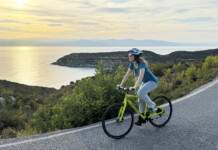
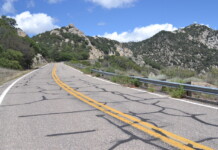
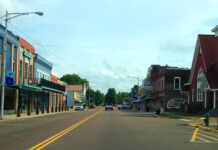


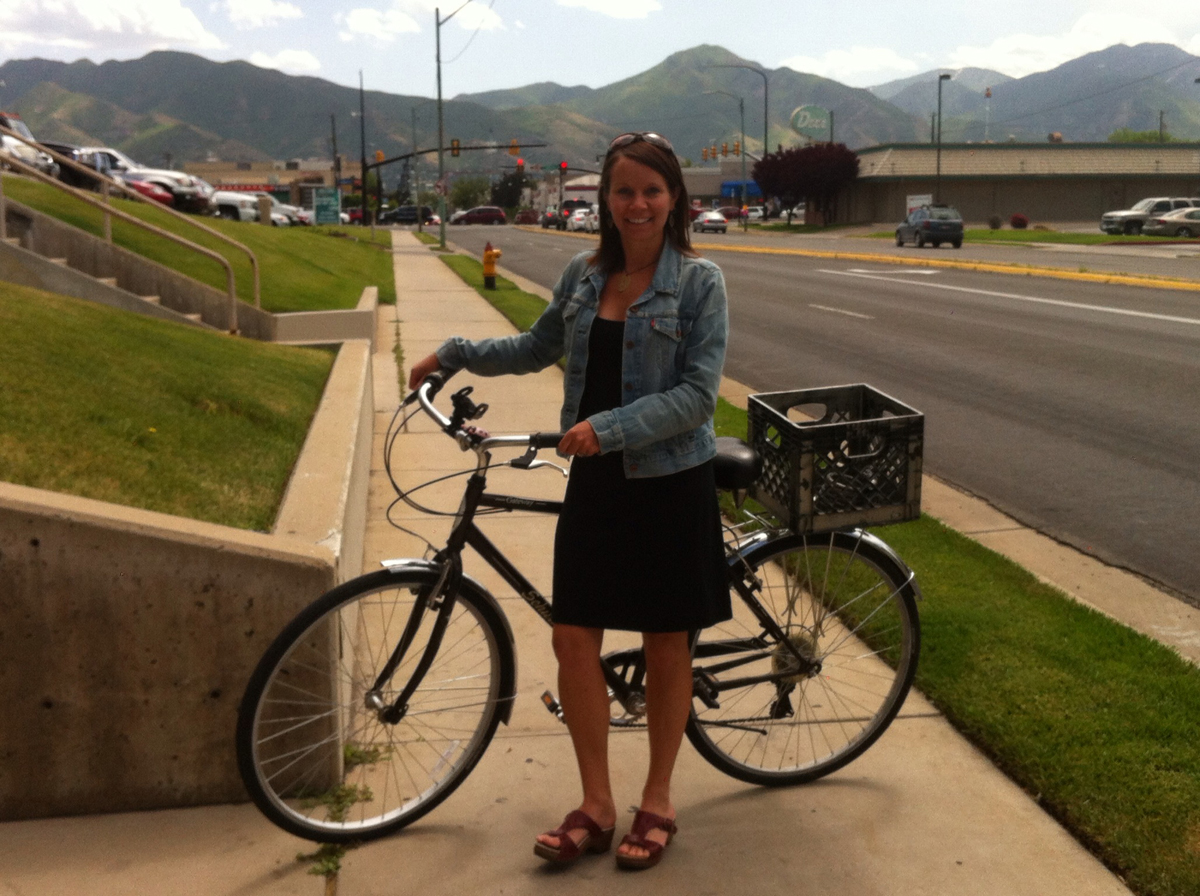


One of my favorite rides! But, I’ll add that the fee shack lady can be quite crabby if you don’t pay to enter. Friends have been ticketed over cruising through.
I forwarded this article on to a friend of mine who works at Dinosaur National Monument, and there’s a couple points that they’d like to add: There is a fee to enter Dinosaur National Monument on a bicycle, it’s $15 for a seven day pass, or you need to have an applicable National Parks Service pass of some sort. If the entrance station happens to be closed or otherwise unmanned, you still need to pay the fee or show your pass at the Visitors Center (which, as mentioned in the above article, is a different building from the Quarry Visitor Center).
https://www.nps.gov/dino/planyourvisit/fees.htm
On a more technical note, in the above article the author helpfully includes the text, most likely from another source, “Among the fossils found were those of the allosaurus, apatosaurus, barosaurus, brontosaurus, camarasaurus, camptosaurus, ceratosaurus, diplodocus, dryosaurus, stegosaurus, and torvosaurus…” All of those names are the name of a genus of dinosaur, so they all should be capitalized (genus names are capitalized, the name of a species is not). It may seem pedantic but, trust me, it’s a big deal to paleontologists.
Also, “Brontosaurus” was a name given to a genus of sauropod that had already been previously described and named “Apatosaurus”, and while some researchers recently proposed that Brontosaurus and Apatosaurus are distinct genera, that doesn’t seem to be widely accepted; so, for the time being anyway, there’s no such genus as “Brontosaurus”. At least not yet.
Comments are closed.